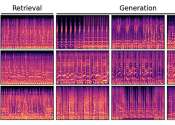Brain2Music taps thoughts to reproduce music
Legendary Stones guitarist Keith Richards once said, "Music is a language that doesn't speak in particular words. It speaks in emotions, and if it's in the bones, it's in the bones."
Hi Tech & Innovation

Legendary Stones guitarist Keith Richards once said, "Music is a language that doesn't speak in particular words. It speaks in emotions, and if it's in the bones, it's in the bones."
Electronics & Semiconductors

For the first time TU Graz's Institute of Theoretical Computer Science and Intel Labs demonstrated experimentally that a large neural network can process sequences such as sentences while consuming four to sixteen times less ...
May 24, 2022
0
245
Robotics

A pair of researchers at Advanced Telecommunications Research Institute International in Japan has developed a brain-machine interface (BMI) to manipulate a robotic arm while the subject's hands engage in a different activity. ...
Hi Tech & Innovation

(Tech Xplore)—A study shows that that nanobots can release drugs inside your brain. The nanorobots, reported New Scientist on Thursday, are built out of DNA. Drugs can be tethered to their shell-like shapes.
Computer Sciences

An international team of researchers from Tübingen and Cold Spring Harbor (New York) has found a pioneering way of determining at what pace changes typically happen. The new method avoids previous systematic errors in estimating ...
Mar 25, 2022
0
156
Computer Sciences

Researchers at the University of Tartu's Computational Neuroscience Lab, in Estonia, have discovered that activations of deep convolutional neural networks are aligned with the gamma band activity of the human visual cortex. ...
Software

Researchers from Carnegie Mellon University, the University Hospital Bonn and the University of Bonn have created an open-source platform known as A-SOiD that can learn and predict user-defined behaviors, just from video. ...
Feb 21, 2024
0
34
Machine learning & AI

For a while, limitations in technology meant that animators and researchers were only capable of creating human-like faces which seemed a little "off."
Nov 8, 2023
0
33
Computer Sciences

Imagine focusing on one thing so well that you can control its movement. Now, imagine mentally selecting colors and shapes to create an abstract image—a brain painting. USF computer scientist Marvin Andujar is harnessing ...
May 20, 2022
0
130
Computer Sciences

The brain analyzes spoken language by recognizing syllables. Scientists from the University of Geneva (UNIGE) and the Evolving Language National Centre for Competence in Research (NCCR) have designed a computational model ...
Jun 26, 2020
0
182
Electroencephalography (EEG) is the recording of electrical activity along the scalp produced by the firing of neurons within the brain. In clinical contexts, EEG refers to the recording of the brain's spontaneous electrical activity over a short period of time, usually 20–40 minutes, as recorded from multiple electrodes placed on the scalp. In neurology, the main diagnostic application of EEG is in the case of epilepsy, as epileptic activity can create clear abnormalities on a standard EEG study. A secondary clinical use of EEG is in the diagnosis of coma and encephalopathies. EEG used to be a first-line method for the diagnosis of tumors, stroke and other focal brain disorders, but this use has decreased with the advent of anatomical imaging techniques such as MRI and CT.
Derivatives of the EEG technique include evoked potentials (EP), which involves averaging the EEG activity time-locked to the presentation of a stimulus of some sort (visual, somatosensory, or auditory). Event-related potentials refer to averaged EEG responses that are time-locked to more complex processing of stimuli; this technique is used in cognitive science, cognitive psychology, and psychophysiological research.
This text uses material from Wikipedia, licensed under CC BY-SA